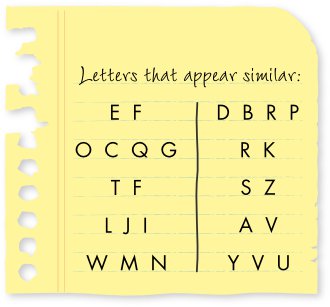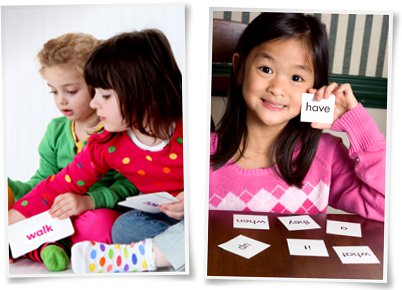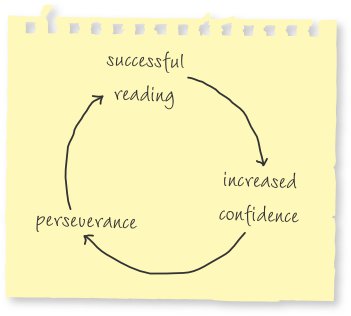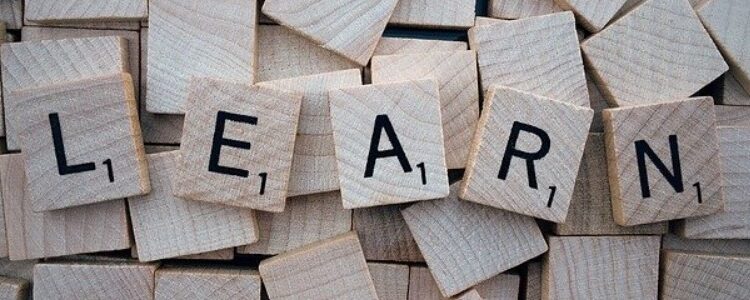Early Childhood Development: Phonological Awareness
Letter and Word Awareness is the ability to identify individual written letters and words. Once children are able to identify printed letters, they develop the ability to identify entire words. The entire developmental progression from letter awareness to word awareness to fluent reading typically begins around age three with letter awareness and continues through age five, six or seven with fluent reading.
Relationship Between Letter and Word Awareness and Visual Discrimination
Letter and Word Awareness is a subset of Visual Discrimination development. Where Visual Discrimination involves the ability to distinguish between numerous similar but different images, Letter and Word Awareness involves only the ability to distinguish between different (but, often time, similarly shaped) letters and words.
For example, the letters E and F have very different sounds and very different roles in reading and writing. However, their appearance is very similar. Consider the many groups of similarly shaped letters:

“Sight Word” Vocabularies
As children begin understanding how letters form words, they will naturally begin recognizing words on a page. Words that begin with the same letter as their name, words that appear frequently in a favorite book and words with a fun sound such as “Woof” are usually the first words children begin identifying. When this happens, children start creating their own personal “sight word” vocabularies.
Sight word vocabularies are the collection of words that your child is able to “read” simply by looking at the word and without having to “sound it out” letter by letter. For example, when a three-year-old child sees a common sign (for a store or restaurant, perhaps), a frequently written word in a favorite book or his own name written down, he is likely able to name that word. He is not reading the word in the conventional sense. Rather, he has memorized what that word looks like in print. In addition to sight words a child learns naturally by seeing the word on favorite signs or in favorite books, some parents and teachers may use “sight word flashcards.” These are created by printing or handwriting commonly used words on one side of small flashcard. By showing a child one card at a time and reading the word aloud to him, he will be able to more quickly expand his sight word vocabulary.

Benefits of Sight Word Vocabularies
Sight word vocabularies foster self-confidence in reading skills. When a child identifies a word from his sight word vocabulary and says it aloud at the appropriate place in a sentence, he believes he is reading. This belief makes him feel successful and helps foster a belief that he is a “good reader.” This confidence will help him to persevere through the challenges of reading increasingly complex words.
Also, all children enjoy feeling successful and your child’s belief that he can read will fuel his desire to continue reading. As with all self-fulfilling cycles of success, this perseverance only further enables success.

Role of Sight Words Once Your Child Starts Reading
Once a child has learned to read by identifying each letter in word and then recalling the appropriate sound each letter makes, “sounding out” each and every word is still time-consuming. Also, many words (such as “where” or “might”) cannot be sounded out using basic phonetic rules. Because of this, your child will continue using sight words long after he learns to read.
For example, each time your child comes across a common word such as “the,” “that” or “and” when reading, he will likely not sound out each letter. Instead, he will remember what the word “the,” for example, looks like and will just say the word aloud each time he sees it. This ability will increase his reading speed and fluency since most sentences contain at least a few common words such as “the” or “that” and your child will be able to quickly “read” these words.
Tips for Accelerating Your Child’s Letter and Word Awareness Development
The first step in helping your young child develop critical letter and word awareness skills is to ensure he knows the names of all 26 uppercase letters. This is most easily taught with flashcards or by writing the uppercase letter on a piece of paper and showing it to your child for numerous successive days as you say aloud the name of the letter. Consider introducing 2 or 3 letters a day until he has learned all 26 letters.
Once your child knows all of the uppercase letters, repeat the process with only lower case letters. To make this activity even more interesting, you can write a few lowercase letters on the right side of a piece of paper and the uppercase letters in a different order on the left side of the paper and have your child match the lowercase letters to their uppercase partners. Or, if you have created flashcards, turn 10 cards at a time upside-down and have your child take turns turning over two cards at a time in an attempt to match the uppercase and lowercase of each letter.
Once your child is able to identify the 26 uppercase and lowercase letters, you can begin helping your child develop an expansive sight word vocabulary. The easiest way to help your child develop a sight word vocabulary is to intentionally point to each word in a book when reading to your child. Books with short, repetitive text are particularly good choices for pre-readers. The repetitive text make it easier for children to memorize the sight of certain words since those words repeat numerous times throughout the book.
Once your child has begun creating a sight word vocabulary, even if it only contains one or two words, incorporate his skills into your daily reading activities. First, have him point along with you as you read each word in a story. Then, as you read aloud, stop before saying a word you believe he may have in his sight word vocabulary. While pointing at it, encourage him to “read” it.
Also, point out and read familiar signs naming stores or restaurants when riding in the car or when taking walks. Begin with signs that have meaning for your child, such as a favorite restaurant. Those types of signs are easiest for children to remember since children (and adults, for that matter) are naturally inclined to remember things and places they like.
When your child is comfortable identifying familiar signs, you can play the “I Spy” game, calling out the name of a store or restaurant and letting your child find the sign or logo. Or, handwrite the name of each room (such as kitchen, bathroom, bedroom, basement) on a separate piece of paper and tape it to that room’s door. Each time your child passes by that room, he will see the word written on the door and begin remembering what the word looks like.
As children become increasingly comfortable “reading” from their sight word vocabulary, they will begin to learn to isolate individual letters within the words in their sight word vocabulary. For example, a child may be able to tell you that the word “BEDROOM” you have posted to his bedroom door “starts with the letter B.” This knowledge of letters then combines with Phonemic Awareness skills to help children learn the sounds associated with each letter. This knowledge will accelerate your child’s ability to quickly master pre-reading skills.
Learn More About What Will Be Expected of Your Child in School
At the start of preschool, children are expected to recognize their first name in print, as well as other common words in favorite books or on favorite store signs. Also, children are expected to understand that words are groups of letters separated by spaces on either side. By kindergarten, children will be expected to know all 26 letters, each letter’s sound(s) and how to properly write each letter. Kindergarten children are also expected to begin conveying ideas through writing, either through “inventive spelling” or by dictating words to an adult. Children in kindergarten are also expected to have a growing “sight word” vocabulary, which they can rely on when “reading” popular books, signs or labels.
Beginning of Preschool
When children start preschool, they are expected to recognize their first name printed in upper case letters. A child’s first name will be written on his locker and any folders or worksheets he uses. Also, a child should know the name of each letter in his name and be able to dictate the proper spelling of his name to an adult. Many children in the classroom will be able to write their first name with varying degrees of accuracy.
During the year, depending on the pre-reading program used in the school, teachers will likely introduce the names of all 26 letters. Children are expected to quickly learn this information and be able to name letters shown to them. Teachers will also begin teaching the children how to write all letters by introducing the proper method for forming each letter. This instruction typically starts by directing the child to write a letter by tracing over a printed model. Then children are expected to write letters freehand by following a guide at the top of the page.
Children are expected to understand that words are groups of letters separated from other words by a space before and after the word. Children should be able to point to and count the number of words in a sentence or on a page.
When teachers read books with large print and repetitive text, children are expected to identify and remember frequently repeated words. Also, labels (such as “door” or “clock”) and classmates’ names will likely be posted in many areas of the classroom. After seeing these words each day for several weeks, children are expected to add these words to the list of words they are able to identify on sight (their “sight word vocabulary”).
Beginning of Kindergarten
At the start of kindergarten, children are expected to recognize both their first and last names written in upper case letters, and accurately spell aloud both their first and last names. They are expected to comfortably point to and count each word in a printed sentence, demonstrating their knowledge that a word is a group of letters with a particular meaning.
As with the preschool year, children will see words posted on bulletin boards, on a “word wall” or as labels in the classroom. They are expected to incorporate these new words into their “sight word vocabulary”.
Letter names and sounds will be reviewed at the beginning of the year to make sure that all children, regardless of their preschool background, have this knowledge. Even children who did not attend a preschool program should be able to identify all 26 letters and remember each letters’ corresponding sound(s) within a few months.
